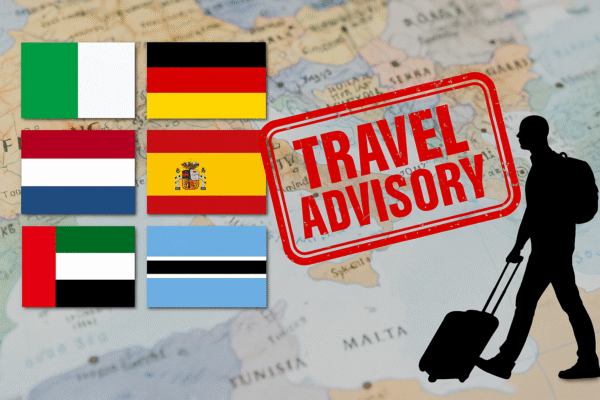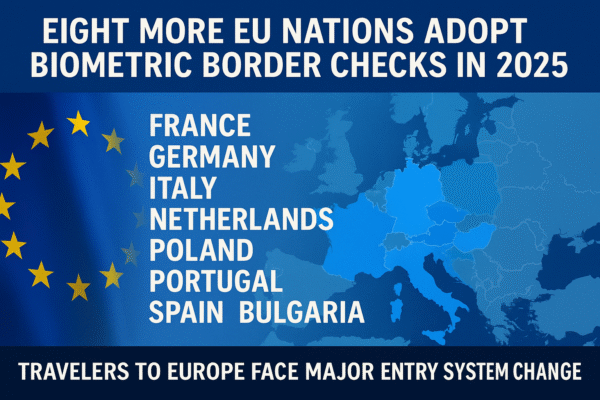As of fall 2025, eight more EU countries — France, Germany, Italy, Netherlands, Poland, Portugal, Spain, and Bulgaria — will fully adopt the European Union’s digital Entry/Exit System (EES), marking a transformative shift in the way non-EU travelers enter the Schengen Area.
This change, already in motion across 19 other European nations, will permanently replace the traditional passport stamp with high-tech fingerprint and facial recognition scans. Together, these 27 Schengen nations are rolling out one of the most ambitious digital border programs in the world — a move designed to modernize entry, reduce wait times, and bolster border security amid record-breaking tourism levels.
What Is the Entry/Exit System (EES)?
The EES is the European Union’s response to mounting pressure on outdated border infrastructure and evolving international security standards. Under this new system, all non-EU nationals entering the Schengen Zone — whether for leisure, business, or transit — will have their identity digitally recorded. This includes biometric data such as four fingerprint scans and a facial image, along with passport details and entry/exit timestamps.
The system will apply across land, air, and sea borders, and will replace manual passport stamping entirely by April 2026.
Rather than receiving an ink stamp at the border, travelers will pass through automated e-gates or biometric kiosks that record their data in seconds. This information will be stored for three years and will help authorities detect overstays, fraud, and unauthorized re-entry.
Why Is the EU Implementing the EES?
The biometric upgrade is part of the EU’s broader Smart Borders initiative, spearheaded by eu-LISA and Frontex. In 2024, the EU recorded over 747 million international tourist arrivals — a figure that surpassed pre-pandemic levels and placed immense strain on border systems. Countries like France, Italy, and Spain, which rank among the world’s most visited, have especially felt the pressure during peak travel seasons.
The EES is designed to reduce bottlenecks, especially at major transit points like:
- Paris Charles de Gaulle Airport (France)
- Frankfurt Airport (Germany)
- Amsterdam Schiphol (Netherlands)
- Madrid-Barajas (Spain)
- Warsaw Chopin (Poland)
By digitizing the process, the EU can handle higher visitor volumes without compromising safety or service quality.
How Will This Affect Non-EU Travelers?
For travelers from countries like the United Kingdom, United States, Canada, Australia, India, and Japan — all visa-exempt for short stays in the Schengen Area — this change will bring several benefits:
- Faster Border Crossings: After initial biometric registration, travelers can use self-service e-gates for subsequent trips, significantly reducing wait times.
- Improved Stay Tracking: The system will automatically calculate the number of days spent in the Schengen Zone, helping avoid violations of the 90/180-day rule.
- Greater Predictability: Business travelers and frequent flyers will benefit from seamless reentry, especially when visiting multiple countries on one itinerary.
EES vs. ETIAS: What’s the Difference?
The Entry/Exit System (EES) is distinct from ETIAS (European Travel Information and Authorization System), although they will work in tandem.
- EES is a biometric system used at border crossings.
- ETIAS, expected to launch in April 2026, will require travelers from visa-free countries to apply online for pre-travel authorization — similar to the U.S. ESTA system.
Both systems aim to make Schengen borders more secure and traveler-friendly. If you’re planning a European trip in late 2025 or beyond, you may be required to complete ETIAS registration online and then undergo biometric checks upon arrival.
Countries Participating in the EES
As of fall 2025, all 27 Schengen member states — including the eight newly onboarded nations — will be part of the EES. These include:
- Western Europe: France, Germany, Italy, Spain, Portugal, Netherlands, Belgium, Austria
- Eastern Europe: Poland, Hungary, Czech Republic, Slovakia, Slovenia, Bulgaria
- Northern Europe: Sweden, Denmark, Finland, Estonia, Latvia, Lithuania
- Southern Europe: Greece, Malta, Croatia
- Microstates and Associated Members: Iceland, Liechtenstein, Norway, Switzerland
Notably, Romania and Bulgaria joined Schengen air and sea borders in March 2024 and are fully integrating with the EES by April 2026.
Lesser-Known Countries to Benefit from Biometric Borders
With easier digital access, countries such as Slovenia, Slovakia, and the Baltic states may see increased interest from travelers seeking multi-country trips. Their efficient new border systems will make them attractive options for tourism, events, and remote work.
Meanwhile, Poland’s growing reputation as a business destination will likely benefit from smoother processing at major airports like Warsaw and Kraków. Bulgaria’s coastal cities and cultural sites, long underexplored by global visitors, may also rise in popularity thanks to faster entry.
A Global Trend Toward Biometric Borders
Europe isn’t alone in embracing border tech. Similar systems are in place in:
- Australia and New Zealand: SmartGate facial recognition
- UAE and Singapore: Iris and face-based clearance
- United States and Canada: Global Entry and Automated Passport Control
- Japan: Facial recognition gates at major airports
- Malaysia: Autogate fingerprint and facial scan system
However, the EU’s EES is unique in its scale — applying the same biometric standard across 27 countries and all entry types (land, sea, air).
Preparing for Your Trip to Europe in 2025–2026
To avoid surprises:
- Make sure your passport is biometric and valid for at least six months.
- Be ready for a one-time fingerprint and facial scan at your first EES border.
- Stay informed about the ETIAS launch and apply for authorization when required.
As European borders go digital, travelers from around the world can expect a faster, smarter, and more secure experience — one that not only protects the Schengen Area’s integrity but also keeps the region welcoming and accessible. With France, Germany, Italy, the Netherlands, Poland, Portugal, Spain, and Bulgaria now onboard, Europe is firmly entering a new era of travel.
For more travel news like this, keep reading Global Travel Wire


















